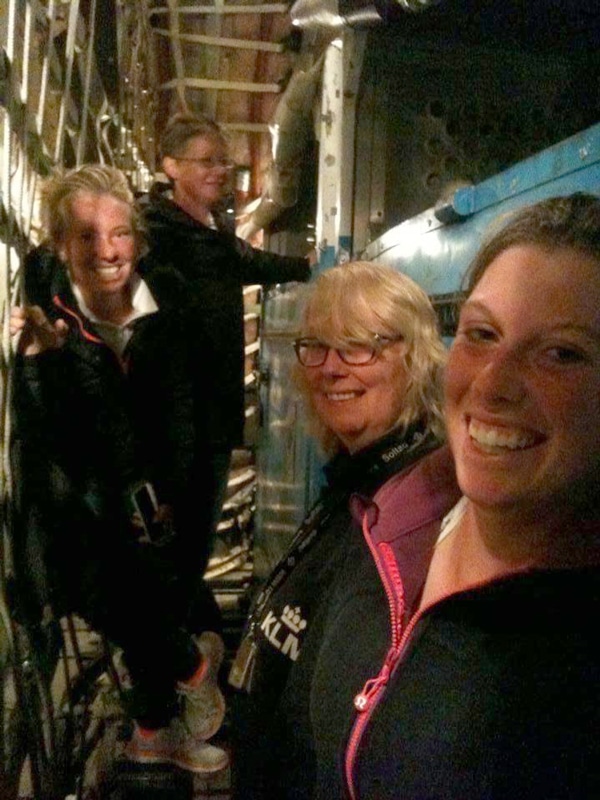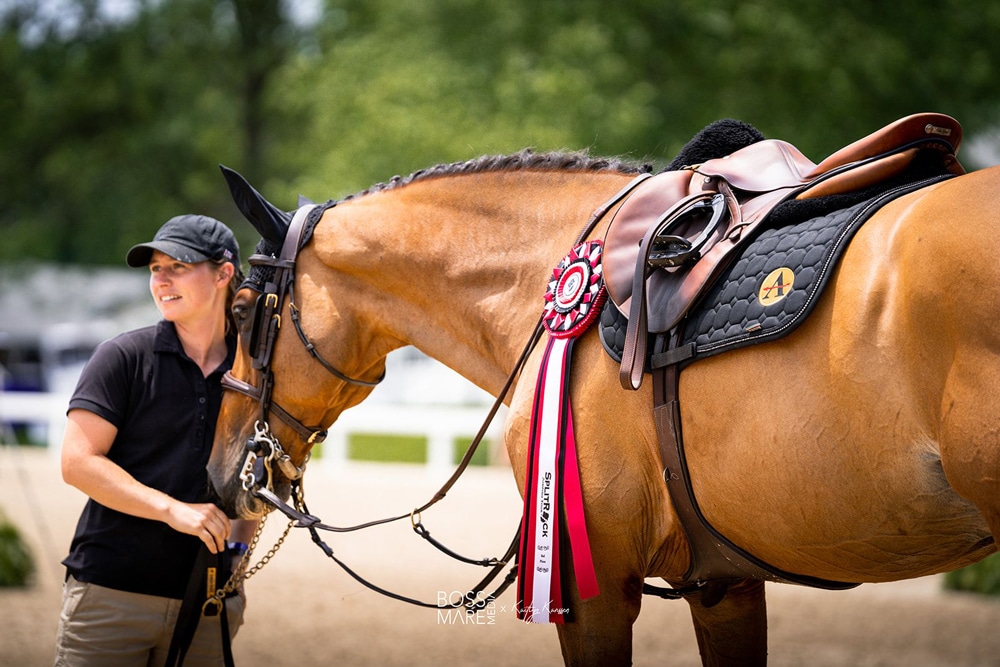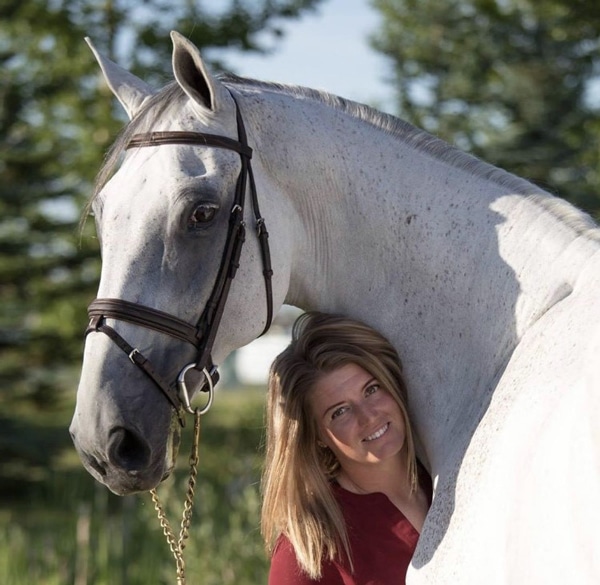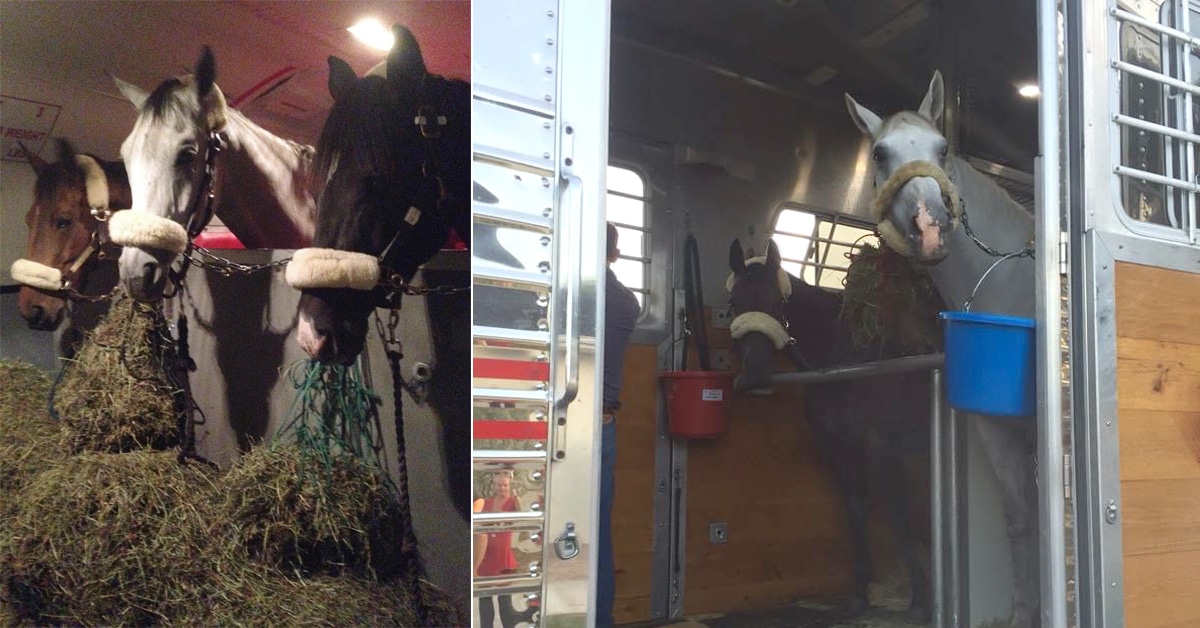If there’s one thing all grooms agree on, it’s that stress-free, safe shipping makes all the difference for horses of top-level competitors. These expert FEI grooms working for dressage riders, showjumpers, and eventers share their best advice for shipping success, accumulated over dozens of years and thousands of kilometers while travelling to Nation’s Cup, Pan America Games, World Equestrian Games, and Olympic Games.
Train Your Horses to “Point and Load”
The best preparation for travelling long-distance starts months and years in advance, by teaching horses not to fear the trailer. To accustom horses to shipping, Jenn Harris, groom for FEI dressage rider Jessica Little, offers simple advice: “Do it more! The more they travel and see and get out the less stress it is on them.”

Jenn Harris and Janine Little on Finley at White Fences in Florida.
Harris underlines that horses should be so comfortable with shipping that they “point and load,” because it ensures the safety of both the horses and their handlers. She recommends “[Taking] young horses out to see the shows before they ever show. …Work on trailer loading with different kinds of trailers in different situations. Borrow other types of trailers like slants, straights, head-to-head.”
Most importantly, choose to train your horse to load in practice situations where stress isn’t high — not in high-anxiety scenarios like “a show, a clinic, the vet, or an emergency.” Setting your horse up for success involves choosing battles you know you can win. “Tuesday afternoons are a great time to feed a horse on a trailer and unload and turn them back out,” says Harris.
Monitor Your Horses Closely
Knowing your horses’ baseline normal physical and mental conditions is a key component of assessing their wellbeing on the road. Jessica Dooley, groom for FEI Showjumper Elizabeth Gingras, says an excellent way to measure your horse’s physical baseline is by becoming familiar with his TPR (temperature, pulse, respiration) ahead of shipping.
Most grooms will agree that knowing the horses’ typical habits and behaviours constitutes the most important part of their job. When watching her horses during transit, Dooley’s main goal “…is to observe they are acting within their normal range: eating, drinking, pooping, and peeing. The more you travel with them the more you know their normal range.” Dooley can immediately assess that a horse isn’t feeling well on a trip if they refuse a favourite like carrots.
Stick to the Routine
According to Sandra Andresen, groom for FEI eventer Jessica Phoenix, keeping to the horses’ normal routines is essential, both when preparing to ship and when on the road. “I always try to keep everything in the routine as normal and stress-free for the horses as possible before a long trip so they can feel their best,” says Andresen. This involves making sure the horses are turned out and get a good night’s sleep before shipping.

Sandra Andresen (against the netting), Sue McTavish (para-dressage groom), Anne Marie Duarte (groom for Selena O’Hanlon) and our KLM attendant on the plane to Amsterdam. (photo courtesy Sandra Andresen)
Andresen stresses the importance of creating a comfortable, familiar environment for equine athletes. She always makes sure “to bring their own buckets, the hay and feed they are used to, and any special treats.”
Leave Time for Rest and Recovery
Because travelling is tiring and stressful, it’s important to alter the horses’ work schedules to compensate, both before shipping and after arrival. This could mean reducing the horses’ workload, but also keeping the horses moving with additional hand-walking or turnout.
Harris stresses how important it is for the horses to arrive “rested and ready” at their new venue. “Arrive early…to allow downtime in their stalls before [you] ask anything of them.” She recommends giving horses, at minimum, as many days off as they spend travelling. “For long trips, especially before we leave Canada for the Florida season, all the horses are given a few days off.”
Hydrate
Many horses are reluctant to drink on the road. Sometimes, bringing water from home or mixing apple juice into the water buckets helps. Mixing water in with food is also an excellent way to compensate for reluctant drinkers. “I always mix warm water in my feeds, but I really make them watery the day before to get the most water into the horse that I can,” says Kyra Holmes, groom for FEI showjumper Nicole Walker.
Dooley also makes “dirty water.” “I will pack small baggies of their normal food with some electrolytes and add lots of water (hence “dirty water”)…to encourage them to keep drinking on the truck.”
Be Organized
To keep on top of the many components of a successful trip, Andresen suggests making “a complete checklist of everything you need for the horse both on the trip and when you arrive. … Travelling by plane, you do not have access to your trunks and equipment during the trip, so you must have everything you need for the journey with you and the horse when you leave the farm.”
Knowing your travel plans are essential. If your plans involve a layover, Holmes suggests getting as much information as possible beforehand. “Laying over can be scary, so making sure the layover facility is safe before you go is important. Asking around if anyone has been there, if it is clean, if the transport truck can get into the driveway, are all very important things to know.”
Holmes says it’s also important to make sure all paperwork is completed early and kept easily accessible. “I keep track of any paperwork that we might need for the border… I always have copies of everything. And if the health papers are on long paper then you have to get the copies on long paper!”

Kyra Holmes. (Boss Mare Media).
Know Traffic / Weather Conditions
“Pay attention to the weather,” Dooley says, “Especially in the winter, know if weather could be an issue. If you need to leave a day early, be prepared.”
Holmes advises choosing shipping times carefully. “In an ideal world I leave at three or four a.m. so that there is no rush-hour traffic … and I like to leave in the evening if we are leaving in a hot climate so they don’t get hot in the truck.”

Jessica Dooley. (Wildrose Imagery)
Leaving yourself extra time to account for travelling conditions will allow you to smoothly compensate for any surprises. “Be prepared for anything!” Andresen says. “Whenever you travel, you can never predict … delays, traffic, unexpected layovers, etc. It is crucial to have enough supplies with you to keep the horses comfortable no matter what happens.”
Choose the Right Tack
Each situation determines the kind of tack you’ll need, Andresen says: “Outfitting horses for shipping depends on a lot of factors including the weather/temperature outside and the type of travel they are doing (plane, trailer, etc.). It also depends strongly on the accessibility to the horses as they travel.”
Dooley recommends a less-is-more approach. “My horses either ship in bell boots only, or bell boots and front shipping boots. I don’t need a horse getting a boot or bandage to slip down and a hauler unable to get to them easily, or a horse to damage a tendon from a bandage slipping and getting too tight.”
If worn, blankets should be monitored constantly to ensure the horses’ optimum temperature. “The trailers do warm up quite a bit from the horses, so I always go a layer less than they would normally be wearing,” says Holmes. “Better to have a cold horse on a truck than a hot, sweaty one.”
When travelling by air, Andresen notes it’s often more practical to ship without any blankets. “The horses are confined to a small crate and it gets quite warm with multiple horses in the small space.”
Never Forget the Must-Haves
- Jenn Harris: Extra lead ropes.
- Sandra Andresen: Double-ended snaps.
- Kyra Holmes: Warm gloves!
- Jessica Dooley: Thermometers.
A big thank you to these wonderful grooms for their excellent advice!

